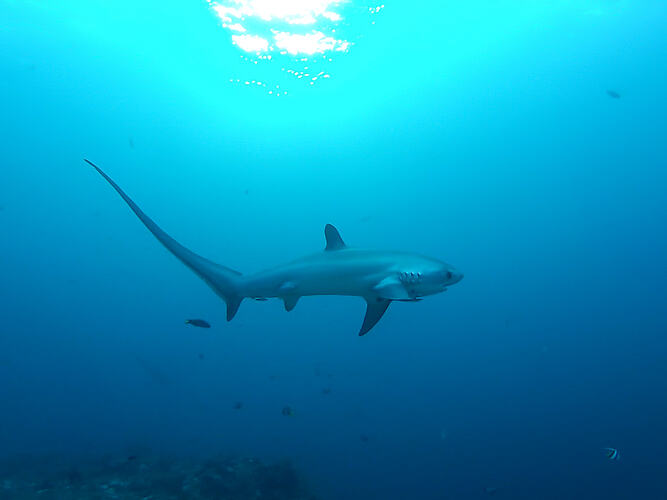General Description
Body spindle-shaped (fusiform) and stout; upper lobe of caudal fin (tail fin) as long or longer than rest of body; head broad; snout broad; eyes relatively small and positioned on midside of head; pectoral fins (the fins on the side of the body) with narrowly rounded tips. Metallic blue-grey to brownish above, underside white, with white area extending above pectoral-fin bases. To 5.7 m in Australia, 7.5 m elsewhere.
Biology
Thresher Sharks have a specialised circulatory system allowing them to maintain body temperatures above that of the surrounding water. This species uses its enormous tail to herd schooling fishes such as mackerel and tailor and sometimes cephalopods towards the surface, where they are stunned by thrashing the tail. Females give birth to live young in shallow coastal waters. The young move offshore as they mature. Thresher sharks are sometimes seen leaping out of the water.
Distribution
Circumglobal in tropical waters. Southern Australian waters from Brisbane (Queensland) to the North West shield (Western Australia).
Habitat
Coastal regions to the open ocean, in surface depths to 650 m.
More Information
-
Animal Type
-
Animal SubType
-
Colours
Blue, White
-
Maximum Size
5.7 m
-
Habitats
-
Diet
Carnivore
-
Hazards
Although not usually considered dangerous to humans, has the potential to bite, or inflict damage with tail.
-
Endemicity
-
Commercial
Yes
-
Conservation Statuses
CITES: Trade restrictions (Appendix II), FFG Threatened List: Not listed, EPBC Act 1999: Not listed, IUCN Red List: Vulnerable
-
Depths
Shallow (1-30 m), Deep ( > 30 m)
-
Water Column Locations
On or near seafloor, Midwater
-
Taxon Name
-
Scientific Author
(Bonnaterre, 1788)
-
Common Name
Thresher Shark
-
Kingdom
-
Phylum
-
Subphylum
-
Superclass
-
Class
-
Subclass
-
Order
-
Family
-
Genus
-
Species Name
vulpinus





